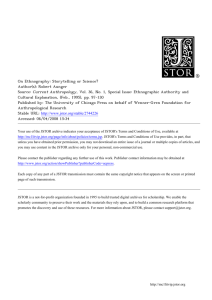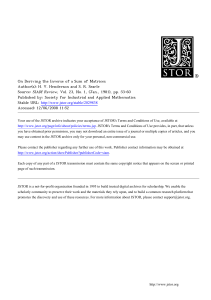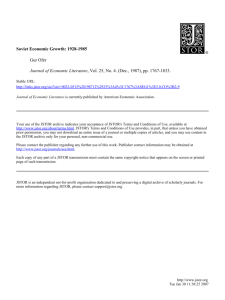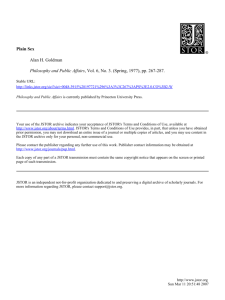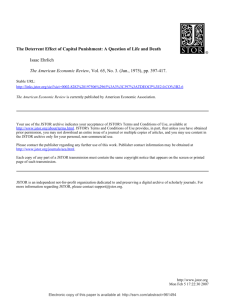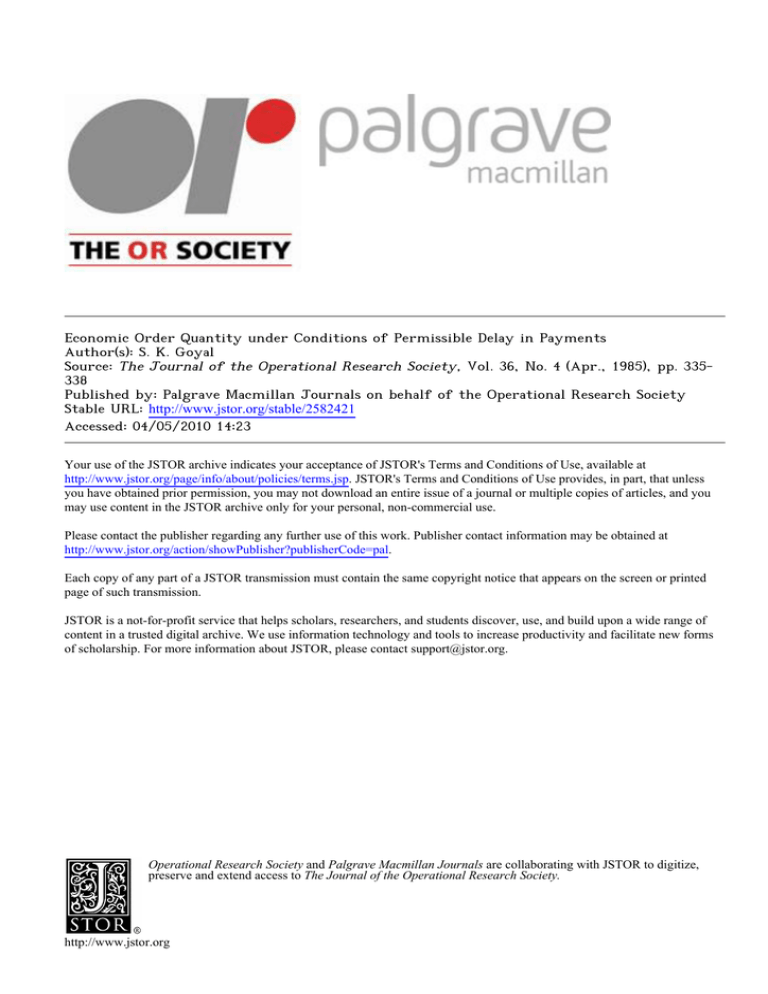
Economic Order Quantity under Conditions of Permissible Delay in Payments
Author(s): S. K. Goyal
Source: The Journal of the Operational Research Society, Vol. 36, No. 4 (Apr., 1985), pp. 335338
Published by: Palgrave Macmillan Journals on behalf of the Operational Research Society
Stable URL: http://www.jstor.org/stable/2582421
Accessed: 04/05/2010 14:23
Your use of the JSTOR archive indicates your acceptance of JSTOR's Terms and Conditions of Use, available at
http://www.jstor.org/page/info/about/policies/terms.jsp. JSTOR's Terms and Conditions of Use provides, in part, that unless
you have obtained prior permission, you may not download an entire issue of a journal or multiple copies of articles, and you
may use content in the JSTOR archive only for your personal, non-commercial use.
Please contact the publisher regarding any further use of this work. Publisher contact information may be obtained at
http://www.jstor.org/action/showPublisher?publisherCode=pal.
Each copy of any part of a JSTOR transmission must contain the same copyright notice that appears on the screen or printed
page of such transmission.
JSTOR is a not-for-profit service that helps scholars, researchers, and students discover, use, and build upon a wide range of
content in a trusted digital archive. We use information technology and tools to increase productivity and facilitate new forms
of scholarship. For more information about JSTOR, please contact support@jstor.org.
Operational Research Society and Palgrave Macmillan Journals are collaborating with JSTOR to digitize,
preserve and extend access to The Journal of the Operational Research Society.
http://www.jstor.org
J. Opl Res. Soc. Vol. 36, No. 4, pp. 335-338, 1985
Printed in Great Britain. All rights reserved
0160-5682/85 $3.00+0.00
Copyright ? 1985 Operational Research Society Ltd
Economic Order Quantity Under Conditions
of Permissible Delay in Payments
S. K. GOYAL
Department of Quantitative Methods, Concordia University, Montreal, Canada
In this paper, mathematical models have been derived for obtaining the economic order quantity for an
item for which the supplier permits a fixed delay in settling the amount owed to him. An example has been
solved to illustrate the method.
Key word: inventory
INTRODUCTION
In deriving the economic order quantity formula, it is tacitly assumed that the supplier must be paid
for the items as soon as the items are received. However, in practice a supplier will allow a certain
fixed period for settling the amount owed to him for the items supplied. Usually there is no charge if
the outstanding amount is settled within the permitted fixed settlement period. Beyond this period,
interest is charged.
When a supplier allows a fixed time period for settling the account, he is actually giving his
customer a loan without interest during this period. During the period before the account has to be
settled, the customer can sell the items and continue to accumulate revenue and earn interest instead
of paying off the overdraft which is necessary if the supplier requires settlement of the account
immediately after replenishment. Therefore, it makes economic sense for the customer to delay the
settlement of the replenishment account up to the last moment of the permissible period allowed by
the supplier. We would now develop the mathematical models for determining the economic order
quantity.
MATHEMATICAL FORMULATION
D = annual demand
h = unit stock-holding cost per item per year excluding interest charges
I,.= interest charges per $ investment in stocks per year
Id= interest which can be earned per $ in a year
p = unit purchase price in $
S = cost of placing one order
t = permissible delay in settling accounts
T = time interval between successive orders
Z(T) = total annual variable cost.
The following assumptions are made in deriving the model.
(1) The demand for the item is constant with time.
(2) Shortages are not allowed.
(3) During the time the account is not settled, generated sales revenue is deposited in an interestbearing account. At the end of this period, the account is settled and we start paying for the
interest charges on the items in stock.
(4) Time period is infinite.
The total annual variable cost consists of the following elements.
(1) Cost of placing orders = S/T.
(2) Cost of stock holding (excluding interest charges). The average stock equals DT/2 (see Figure
1), hence stock-holding cost per year is given by DTh/2.
(3) Cost of interest charges for the items kept in stock. As items are sold, and before the replenishment account is settled, the sales revenue is used to earn interest. When the replen335
Journal of the Operational Research Society Vol. 36, No. 4
0
IT
Dr~~~
t
(T-t)
~~~~~~~~Time
T
FIG.
1. Time-weighted
inventory when T
t.
?
ishment account is settled, the situation is reversed, and effectively the items still in stock have
to be financed at interest rate I,. The stock level at the time of settling the replenishment
account equals D(T
-
t) (see Figure 1) and the interest is payable during time (T
Interest payable per year =
Dp(T -
_T
t)2j
DpTI
2
t).
) c.
2
Interest payable in one cycle -p
-
+
Dpt2I
Dpt2I.
p
(4) Interest earned during the permissible settlement period. The maximum accumulated amount
earning interest during the settlement period equals Dtp if T > t (see Figure 1) or DTp if
T < t (see Figure 2). Hence the interest earned during the permissible settlement period for
the two cases is obtained as follows:
Case I: T
t, shown in Figure I
)
Interest earned in one cycle = Dpt 2Id
2
Interest earned in one year
Case II: T
<
=
t
2d
t, shown in Figure 2
Interest earned in one cycle =
+ DTp(t-T))Id
Interest earned in one year = DpId(t-T
0)~~~~(tT
0)
C-)
}D'D
tLST)
FIG. 2. Time-weighted inventory when T < t.
336
=DTpId(t
-
S. K. Goyal-Economic Order Quantity Under Conditions of Permissible Delay in Payments
Note that the interest earned should be subtracted from other variable costs in order to get
the total variable cost per year.
Now we shall develop the mathematical models for determining economic order quantities for
the two cases.
DETERMINATION OF ECONOMIC ORDER QUANTITY WHEN T
t
In this case the total variables cost per year is given by
Z(T)=-
S
DTh
T
2
DTpIC
~+-
2
+
2Id
- DptT
2
Dpt I2I
2T c-DptI
or
(5++ Dpt2(Ic
(
Z(T) = (2S
I)) + D
(h + pI) - Dpt.
-
In order to minimize Z(T), set [dZ(T)/dT]
T.*
= /(
1D
(1)
~~2
2T
=
0 and obtain the economic value of T =T
(2+Dpt2(j-c))
Dh
(h + ph)
(2)
).(2)
0 for
It may be pointed out that the effect of use of money, which means t > 0 and (Ic -Id)
normal conditions, is to increase the apparent order placement cost. The economic order quantity
Q(T ) and the minimum annual variable cost Z(T ) are given by
Q(T*)
1( ) =DT*=1'
j
D(2S + Dpt2(Ic
-
Id))
(h +pIj)
(3)
and
Z(T*)
=
,/D(2S + Dpt2(I
-Id))
(h +
-
DptIc.
(3a)
As a result of permissible delay in settlement of the replenishment account, the order quantity as
obtained by (3) is generally higher than the order quantity given by the classical economic order
quantity model given by
2DS/(h+ph)
Q*
(3b)
The extent of such a change in the order quantity depends entirely on the parameters of the
problem situation. When Ic = Id, then the economic order quantity given by (3) is exactly equal to
the order quantity obtained from the classical economic order quantity model. On the other hand,
the highest value of Q(T ) is obtained when the funds cannot be invested (Id = 0). Under such
conditions, the economic order is given by
D(2S + Dpt2j,)
(h + pI)
In the rare case when I - Id < 0, the economic order quantity obtained from (3) is lower than the
economic order quantity obtained from the classical economic order quantity model.
DETERMINATION OF ECONOMIC ORDER QUANTITY WHEN T < t
In this case, no interest charges are paid for the items kept in stock. The total variable cost in this
case is given by
Z()
S +DTh
Z(T) =-?+
DI(
T)
(h +pld)-Dptld.
337
(4)
Journal of the Operational Research Society Vol. 36, No. 4
Hence the economic order interval and the order quantity are given by
T * =2
A
;(5)
D h +pld)(5
and
Q(T* ) 2= DT*2 =~
2SD
(h -/
+pld)(6
(6)
Note that for I, ) Id Q(Tfl) > Q*
It may be pointed out that the total annual variable cost, Z(t), at T= t is obtained on
substituting T = t in (1) or in (4).
S
Z(t) =+
t
D th Dptld
2
2 2
2
(7)
and
Q(t) = Dt.
(8)
In order to obtain the economic operating policy, follow these steps:
Step 1: Determine T1 from (2). If T1 ) t, obtain Z(T ) from (1).
Step 2: Determine Tf from (5). If T2 < t, evaluate Z(Tf ) from (4).
Step 3: If T1 < t and T2 ) t, then evaluate Z(t) from (7).
Step 4: Compare Z(T *), Z(Tf ) and Z(t). Select the replenishment interval and the order quantity
associated with the least annual cost value evaluated in steps 1 and 2 or 3.
CONCLUDING REMARKS
As a result of permissible delay in settling the replenishment account, the economic replenishment interval and order quantity generally increases marginally, although the annual cost decreases
considerably. The saving in cost as a result of permissible delay in settling the replenishment
account largely comes from the ability to delay payment without paying any interest. As a result of
increased order quantity under conditions of permissible delay in payments, we need to order less
often. The economic order quantity model given in this paper is an extension of the classical
economic order quantity model and hence can be used in a similar manner for determining ordering
policy for items having probabilistic demand.
Acknowledgement-I am very much indebted to the two referees for their valuable comments and suggestions.
338


